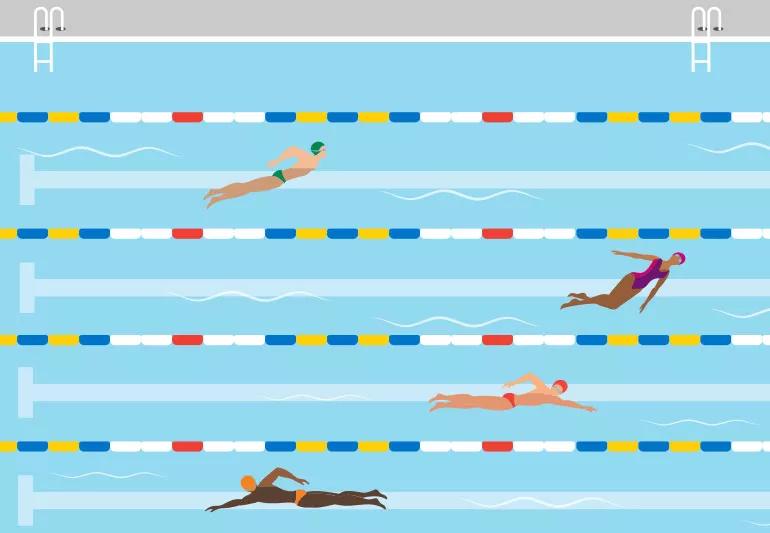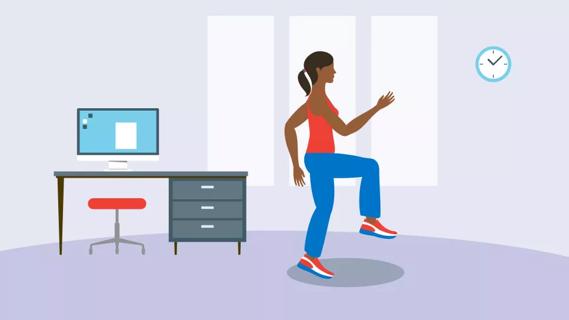A lower-impact way to keep your heart strong and your mind sharp — and it’s so relaxing!

Remember the joy of childhood when you’d spend a hot summer day splashing around in a cold pool with friends? Maybe you were even on the swim team growing up, and the sound of a whistle takes you back to those starting splashes at the beginning of a race.
Cleveland Clinic is a non-profit academic medical center. Advertising on our site helps support our mission. We do not endorse non-Cleveland Clinic products or services. Policy
Why not rediscover that love of the water as an adult? Exercise physiologist Christopher Travers, MS, explains why swimming — along with other aquatic exercises like water walking and water aerobics — is so good for your body and mind.
Swimming isn’t just good exercise, it’s great exercise. That’s thanks to the water itself, which offers buoyancy and resistance that makes it easier on your whole body than other forms of exercise.
“As cardiovascular exercises go, swimming offers a little less wear and tear on the body than other options,” Travers says. “It’s a good choice for just about anyone.”
We love an equal-opportunity physical activity! Swimming is for people of various ages, weights and health conditions, and no matter your activity level, you’ll reap some of its benefits. Travers shares nine of them.
We’re not saying that swimming is easy (far from it!), but swimming takes much less of a toll on your body than, say, running or riding a bike. That’s because exercising in water lessens the impact of your body weight on your joints.
“The buoyancy of the water takes the weight off,” Travers says. “It also adds resistance, but it’s low impact.” This is especially helpful if you have a condition that causes stiffness or joint pain:
Want to keep your ticker at peak function? Cardio activity is one of the keys to a healthy heart, and swimming’s cardiovascular benefits are clear. It’s been shown to:
“A major study commissioned by Swim England found that swimmers have a 41% lower risk of death due to heart disease or stroke than non-swimmers,” Travers shares, “plus a 28% lower risk of early death overall.”
It’s even an option for people who are in cardiac rehabilitation. Studies show that swimming can be well-tolerated by people who are recovering from heart failure or coronary artery disease.
Of course, always check with your healthcare provider before starting a new exercise routine, especially if you’re recovering from a major cardiac or have a known medical condition. And if you’ve had open-heart surgery or another procedure, be sure to stay out of the pool until your surgical incisions have healed.
If you want to breathe easier, swimming might help do the trick. It’s been found to improve lung strength and capacity.
“Swimming makes your body use oxygen more efficiently,” Travers says, “so if you’ve been diagnosed with asthma or chronic obstructive pulmonary disease (COPD), it can be a good exercise to try.”
That said, studies have also shown that long-term exposure to the disinfectants used to clean swimming pools can actually increase your asthma risk. So, proceed with caution and always check with your healthcare provider to make sure swimming is safe for you.
Like other forms of cardio, swimming can help you burn calories and lose weight.
According to the U.S. Centers for Disease Control and Prevention (CDC), a 154-pound person who swims slow freestyle laps for 30 minutes burns 255 calories. But that amount varies depending on your weight, speed and stroke.
Swim England reports that butterfly stroke burns the most calories, but because it can be so hard to learn and to maintain — especially for beginners — it’s not recommended as a weight loss go-to. Freestyle is the better option, and only after you’ve learned how to do it the right way.
The built-in resistance that water provides helps build muscles and makes you stronger. And because water is more resistant than air, swimming does this faster than land workouts like running and biking.
“When you swim, you’re getting better aerobic capacity, and you’re working your muscles because you’re working against the resistance of the water,” Travers states.
More research is needed, but studies suggest that regular swimming can improve cognitive (mental) function, which is especially important as you age. And speaking of aging…
Getting older? Hey, aren’t we all — but swimming is a great exercise choice to help you maintain your health as the years pile on.
A study of postmenopausal women with high blood pressure found that swimming reduced blood pressure and improved arterial stiffness.
Menopause also causes your bone density to decline, which can lead to weak and brittle bones. But swimming has been shown to have a positive effect on bone health in post-menopausal people. It may even be able to help stave off osteoporosis in people who’ve not yet entered menopause.
“When you’re postmenopausal, it’s important that you’re always looking for ways to increase bone density,” Travers advises.
It’s no secret that feeling better physically can help you to feel better mentally.
Remember that study we mentioned earlier, of women with fibromyalgia who swam for eight months? They didn’t just show improvements in physical health: They also reported a 41% improvement in anxiety and a 27% improvement from depression.
Plus, swimming is one of those activities that allows you to block out the world around you and just be. Whether you get lost in your own thoughts or use waterproof technology to listen to music while you do it, swimming can be a great way to destress and reap some of the benefits of meditation while also engaging in physical fitness.
You don’t have to start swimming Olympic-level laps to reap the benefits of being in the water. Other water activities can be beneficial, too.
“If you’re a bit of a reluctant exerciser, or if you’re recovering from a heart attack or a heart arrhythmia, you can start small with something like water walking or water aerobics,” Travers suggests. “These activities can feel a little bit more accessible than lap-swimming.”
Start in water that’s about up to your waist. Walking slowly across the pool, swing your arms and keep your back straight.
“As you increase your strength and endurance, you can add water weights or hand webs, which act like weights working with the resistance in the water,” Travers suggests.
If you’re comfortable, you can move into deeper water. Some pools even offer a designated time for water walking in their “lazy river,” a shallow, flowing, artificial river.
As you increase your tolerance for water exercise, you may be interested in enrolling in a water aerobics class at your local gym or health facility. These classes combine the benefits of a water workout with the camaraderie and fun of a being in a group exercise setting.
The American College of Sports Medicine’s physical activity guidelines call for 150 minutes of moderate-intensity aerobic exercise every week. But what does that mean, especially if you’re not an athlete?
Travers puts it simply: Any exercise is better than no exercise, especially if you haven’t been working out at all. If you start swimming (or water walking or water aerobics), you’re going to experience some of its benefits, period — even if you’re not doing it for 150 minutes per week.
“One of the biggest misconceptions that people have is that they need to be pouring sweat when they’re during cardio,” he says. “But really, you just need to get up and move. Anything is better than being sedentary.”
If you sit at a desk all day, any additional movement is better than no movement at all. Start where you can and work up to that weekly recommended amount.
OK, we’ve convinced you: It’s time to start swimming. But, uhh… now what?
It may sound silly, especially if you know how to keep your head above water, but Travers recommends taking lessons.
“You’re never too old to get a swimming lesson,” he says — and yes, they do exist. Most pools that offer lap swimming also offer lessons or can help you find someone who does. Travers says that although adult swimming coaches often train triathletes, they can just as easily teach you the basics.
He shares some additional tips for first-time and returning swimmers:
Speaking of healthcare providers: Before starting any new physical activity, ask whether if it’s safe for you. In this case, that’s especially true if you’ve never swam before or lead a very sedentary lifestyle.
But if you get the A-OK, wade on in! The water’s fine, and before you know it, you’ll be channeling your inner Nemo — and reaping a ton of health benefits, too.
Learn more about our editorial process.

This simple phrase encourages you to enjoy your workouts, not dread them

Chair exercises can help people age 65+ retain independence

Both are needed for a healthy body

Counteract psoas muscle stiffness and soreness with stretches that lengthen and strengthen

It may be OK, depending on your health, fitness level and type of exercise

Simple exercises like wall angels and pelvic tilts can help keep your body in an optimal position — and help undo years of improper posture habits

Sea lice aren’t really lice, but these tiny creatures can trigger an unpleasant allergic reaction

Losing belly fat can reduce your risk for chronic health conditions — try focusing on a diet high in lean protein, exercising regularly, reducing stress and getting quality ZZZs

Your metabolism may torch 1,300 to 2,000 calories daily with no activity

A gentle touch in all the right places may help drain your sinuses